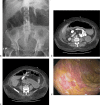Persistent and Recurrent Clostridium difficile Colitis
- PMID: 26034401
- PMCID: PMC4442717
- DOI: 10.1055/s-0035-1547333
Persistent and Recurrent Clostridium difficile Colitis
Abstract
Clostridium difficile infection (CDI) is the most frequent cause of nosocomial diarrhea. It has become a significant dilemma in the treatment of patients, and causes increasing morbidity that, in extreme cases, may result in death. Persistent and recurrent disease hamper attempts at eradication of this infection. Escalating levels of treatment and novel therapeutics are being utilized and developed to treat CDI. Further trials are warranted to definitively determine what protocols can be used to treat persistent and recurrent disease.
Keywords: BI/NAP1/027; fecal microbiota therapy; recurrent Clostridium difficile.
Figures




Similar articles
-
Best strategies in recurrent or persistent Clostridium difficile infection.Surg Infect (Larchmt). 2011 Jun;12(3):235-9. doi: 10.1089/sur.2010.080. Epub 2011 Jul 18. Surg Infect (Larchmt). 2011. PMID: 21767157 Review.
-
Fecal Microbiota Transplant: Treatment Options for Clostridium difficile Infection in the Intensive Care Unit.J Intensive Care Med. 2016 Oct;31(9):577-86. doi: 10.1177/0885066615594344. Epub 2015 Jul 3. J Intensive Care Med. 2016. PMID: 26141116 Review.
-
Transient flare of ulcerative colitis after fecal microbiota transplantation for recurrent Clostridium difficile infection.Clin Gastroenterol Hepatol. 2013 Aug;11(8):1036-8. doi: 10.1016/j.cgh.2013.04.045. Epub 2013 May 10. Clin Gastroenterol Hepatol. 2013. PMID: 23669309
-
Fecal Microbiota Transplantation in Recurrent NAP1/B1/027 Clostridium Difficile Infection (CDI) Resistant to Vancomycin and Metronidazole in a Patient with Ulcerative Colitis (UC): A Case Report.Rev Med Chir Soc Med Nat Iasi. 2016 Jul-Sep;120(3):563-7. Rev Med Chir Soc Med Nat Iasi. 2016. PMID: 30044904
-
Clostridium difficile - From Colonization to Infection.Front Microbiol. 2018 Apr 10;9:646. doi: 10.3389/fmicb.2018.00646. eCollection 2018. Front Microbiol. 2018. PMID: 29692762 Free PMC article. Review.
Cited by
-
Predicting clinical trial success for Clostridium difficile infections based on preclinical data.Front Artif Intell. 2024 Oct 9;7:1487335. doi: 10.3389/frai.2024.1487335. eCollection 2024. Front Artif Intell. 2024. PMID: 39444663 Free PMC article.
-
Identification of a family of peptidoglycan transpeptidases reveals that Clostridioides difficile requires noncanonical cross-links for viability.Proc Natl Acad Sci U S A. 2024 Aug 20;121(34):e2408540121. doi: 10.1073/pnas.2408540121. Epub 2024 Aug 16. Proc Natl Acad Sci U S A. 2024. PMID: 39150786
-
Current and Ongoing Developments in Targeting Clostridioides difficile Infection and Recurrence.Microorganisms. 2024 Jun 15;12(6):1206. doi: 10.3390/microorganisms12061206. Microorganisms. 2024. PMID: 38930588 Free PMC article. Review.
-
"Primum, non nocere": The Epidemiology of Toxigenic Clostridioides difficile Strains in the Antibiotic Era-Insights from a Prospective Study at a Regional Infectious Diseases Hospital in Eastern Europe.Antibiotics (Basel). 2024 May 17;13(5):461. doi: 10.3390/antibiotics13050461. Antibiotics (Basel). 2024. PMID: 38786189 Free PMC article.
-
Antimicrobial Effects of Some Natural Products on Adhesion and Biofilm Inhibition of Clostridioides difficile.Pharmaceutics. 2024 Mar 30;16(4):478. doi: 10.3390/pharmaceutics16040478. Pharmaceutics. 2024. PMID: 38675139 Free PMC article.
References
-
- Lamont J T Up to Date: Clostridium difficile in adults: Epidemiology, microbiology, and pathophysiology Available at: http://www.uptodate.com/contents/clostridium-difficile-in-adults-epidemi.... Last updated June 24, 2014. Accessed on June 28, 2014.
-
- Stanley JD(1), Bartlett J G Dart B W 4th Ashcraft J H Clostridium difficile infection Curr Probl Surg 2013507302–337. - PubMed
-
- Surawicz C M Brandt L J Binion D G et al.Guidelines for diagnosis, treatment, and prevention of Clostridium difficile infections Am J Gastroenterol 20131084478–498., quiz 499 - PubMed
-
- Cohen S H, Gerding D N, Johnson S. et al.Clinical practice guidelines for Clostridium difficile infection in adults: 2010 update by the society for healthcare epidemiology of America (SHEA) and the infectious diseases society of America (IDSA) Infect Control Hosp Epidemiol. 2010;31(5):431–455. - PubMed
-
- Kelly C P, LaMont J T. Clostridium difficile—more difficult than ever. N Engl J Med. 2008;359(18):1932–1940. - PubMed
Publication types
LinkOut - more resources
Full Text Sources
Other Literature Sources


